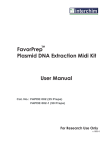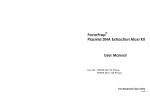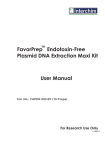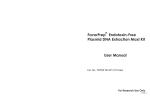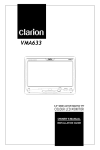Download User Manual FavorPrep Plasmid DNA Extraction Mini
Transcript
TM FavorPrep Plasmid DNA Extraction Mini Kit User Manual Cat. No.: FAPDE 001 (100 Preps) FAPDE 001-1 (300 Preps) For Research Use Only v.1103 Introduction Troubleshooting FavorPrep Plasmid Extraction Mini Kit is an excellent tool offering a speed and economic method to purify plasmid DNA from bacteria cultures. This technology is based on binding DNA to silica-based membranes in chaotropic salts, washing DNA with ethanol-contained Wash Buffer. Compare with other harmful and time-consuming procodure, such as phenol/ chloroform extraction and ethanol precipitation, FavorPrep Plasmid extraction kit shortens the handling time to about 25 minutes. The high quality plasmid DNA can be used directly for the downstream application. RNA Contaminates Plasmid DNA Insufficiency of RNase A activity in FAPD1 Buffer because of long-term storage •Prior to using FAPD1 Buffer, ensure that RNase A was added. If RNase A added FAPD1 Buffer is out of date, add additional RNase A into FAPD1 Buffer to a concentration of 50μg/ml then store 4°C. •Too many bacterial cells were used, reduce sample volume. Smearing or degrading of Plasmid DNA Nuclease contamination Specification •If used host cells have high nuclease activity (e.g., enA+ strains), perform this Optional Wash Step to remove residuary nuclease. Sampling: 1~5 ml overnight culture Plasmid Size: < 12Kb Yield: 20~30 µg of high-copy plasmid Handing time: about 25 min •After DNA Binding Step, add 400μl of W1 Buffer into FAPD column and column and incubate for 2 minutes at room temperature. •Centrifuge at full speed (14,000 rpm or 10,000 xg) for 30 seconds. •Followed using standard Wash Step. Kit Contents FAPD1 Buffer FAPD2 Buffer FAPD3 Buffer W1 Buffer (concentration)* Wash Buffer (concentration)** Elution Buffer RNase A (50mg/ml) FAPD Column Collection Tube User Manual FAPDE 001 FAPDE 001-1 30 ml 30 ml 40 ml 35 ml 20 ml 15 ml 60 µl 100 pcs 100 pcs 1 90 ml 90 ml 120 ml 98 ml 50 ml 35 ml 180 µl 300 pcs 300 pcs 1 Plasmid DNA is not adequate for enzymatic digestions Eluted plasmid DNA contains residual ethanol •Make sure you have discarded the flow-through after washing with Wash Buffer (Step 9) and centrifuged for an additional 3 minutes (Step 10). Denatured Plasmid DNA migrate faster than supercoilded form during electrophoresis Incubation in FAPD2 Buffer is too long •Do not incubate longer than 5 minute in FAPD2 Buffer * Add 13 ml/ 36 ml ethanol (96 ~ 100%) to W1 Buffer when first open. ** Add 80 ml/ 200 ml ethanol (96 ~ 100%) to Wash Buffer when first open. 1 6 Important Notes Troubleshooting Low yield Bacterial cells were not lysed completely •Too many bacterial cells were used (OD600 > 10). Separate the bacterial culture into multiple tubes. •After FAPD3 Buffer addition, break up the precipitate by inverting to ensure higher yield. Overgrown of bacterial cells •Incubation time should not longer than 16 hours. Bacterial cells were insufficient •Ensure that bacterial cells have grown to an expected amount (OD600 > 1) after incubation under suitable shaking modes. Incorrect DNA Elution Step •Ensure that Elution Buffer was added and absorbed to the center of FAPD Column Martix. Incomplete DNA Elution •If size of DNA fragments is larger than 10 kb, use preheated Elution Buffer (60~70°C) on Elution Step to improve the elution efficiency. 1. Buffer provided in this kit contain irritants. Wear gloves and lab coat when handling these buffer. 2. Brief spin RNase A tube to remove drops from the inside of the lid. Add 1 ml of FAPD1 Buffer into RNase A tube and mix well. Transfer the mixture into FAPD1 Buffer bottle and store at 4 º C. 3. Check FAPD2 Buffer before use. Warm FAPD2 Buffer at 55 º C for 10 minutes if any precipitation formed. Don’t shake FAPD2 Buffer vigorously. 4. To avoid acidification of FAPD2 Buffer from CO2 in the air, close the bottle immediately after use. 5. For FAPDE 001, add 13 ml ethanol (96~100%) to W1 Buffer when first open. For FAPDE 001-1, add 36 ml ethanol (96~100%) to W1 Buffer when first open. 6. For FAPDE 001, add 80 ml ethanol (96~100%) to Wash Buffer when first open. For FAPDE 001-1, add 200 ml ethanol (96~100%) to Wash Buffer when first open. 7. All centrifuge steps are done at full speed (14,000 rpm or 10,000 x g) in a microcentrifuge. Brief Procedure Incorrect Wash Buffer (FAPD1) (FAPD2) (FAPD3) •Ensure that Ethanol was added to Wash Buffer pior to use. Eluted DNA does not perform well Residual ethanol contamination •After Wash Step, dry FAPD Column with additional centrifugation at top speed for 5 minutes or incubation at 60°C for 5 minutes. Genomic DNA Contaminates Lysate prepared improperly. •Gently invert the tube after adding FAPD2 Buffer. And the incubation time should not longer than 5 minutes. •Do Not use overgrown bacterial culture. 5 2 1. Transfer 1-5 ml of well-grown bacteria culture to a microcentrifuge tube (not provided). 2. Descend the bacteria by centrifuging for 1-2 min and discard the supernatant completely. 3. Add 250 µl of FAPD1 Buffer to the pellet and resuspend the cells completely by pipetting. • Make sure that RNase A has been added into FAPD1 Buffer when first open. • No cell pellet should be visible after resuspension of the cells. 4. Add 250 µl of FAPD2 Buffer and gently invert the tube 5 times to lyse the cells and incubate at room temperature for 2 min. • Do not vortex, vortex may shear genomic DNA. If necessary, continue inverting the tube until the lysate beccome clear. • Do not proceed this step over 5 min. 5. Add 350 µl of FAPD3 Buffer and invert the tube 5 times immediately but gently. • Invert immediately after addind FAPD3 Buffer will avoid asymmetric precipitation. 6. Centrifuge for 10 min. During centrifuging, place a FAPD Column in a Collection Tube. 9. Add 750 µl of Wash Buffer to FAPD Column. Centrifuge for 1 min then discard the flow-through. • Make sure that ethanol (96-100 %) has been added into Wash Buffer when first open. 10. Centrifuge for an additional 3 min to dry the column. • Important step ! This step will remove the residual liquid completely that will inhibit subsequent enzymatic reaction. 11. Place FAPD Column to a new 1.5 ml microcentrifuge tube (not provided). 12. Add 50 µl ~ 100 µl of Elution Buffer or ddH2O to the membrane center of FAPD Column. Stand the column for 1 min. • Important step ! For effective elution, make sure that the elution solution is dispensed on the membrane center and is absorbed completely. • Important : Do not Elute the DNA using less than suggested volume (50ul). It will lower the final yield. 13. Centrifuge for 1 min to elute plasmid DNA. 14. Store plasmid DNA at 4 °C or -20 °C. 7. Transfer the suspernatant carefully to FAPD Column. Centrifuge for 1 min then discard the flow-through. • Do not transfer any white pellet into the column. 8. Add 400 µl of W1 Buffer to FAPD Column. Centrifuge for 1 min then discard the flow-through. • Make sure that ethanol (96-100 %) has been added into W1 Buffer when first open. 3 4 1. Transfer 1-5 ml of well-grown bacteria culture to a microcentrifuge tube (not provided). 2. Descend the bacteria by centrifuging for 1-2 min and discard the supernatant completely. 3. Add 250 µl of FAPD1 Buffer to the pellet and resuspend the cells completely by pipetting. • Make sure that RNase A has been added into FAPD1 Buffer when first open. • No cell pellet should be visible after resuspension of the cells. 4. Add 250 µl of FAPD2 Buffer and gently invert the tube 5 times to lyse the cells and incubate at room temperature for 2 min. • Do not vortex, vortex may shear genomic DNA. If necessary, continue inverting the tube until the lysate beccome clear. • Do not proceed this step over 5 min. 5. Add 350 µl of FAPD3 Buffer and invert the tube 5 times immediately but gently. • Invert immediately after addind FAPD3 Buffer will avoid asymmetric precipitation. 6. Centrifuge for 10 min. During centrifuging, place a FAPD Column in a Collection Tube. 9. Add 750 µl of Wash Buffer to FAPD Column. Centrifuge for 1 min then discard the flow-through. • Make sure that ethanol (96-100 %) has been added into Wash Buffer when first open. 10. Centrifuge for an additional 5 min to dry the column. • Important step ! This step will remove the residual liquid completely that will inhibit subsequent enzymatic reaction. 11. Place FAPD Column to a new 1.5 ml microcentrifuge tube (not provided). 12. Add 50 µl ~ 100 µl of Elution Buffer or ddH2O to the membrane center of FAPD Column. Stand the column for 1 min. • Important step ! For effective elution, make sure that the elution solution is dispensed on the membrane center and is absorbed completely. • Important : Do not Elute the DNA using less than suggested volume (50ul). It will lower the final yield. 13. Centrifuge for 1 min to elute plasmid DNA. 14. Store plasmid DNA at 4 °C or -20 °C. 7. Transfer the suspernatant carefully to FAPD Column. Centrifuge for 1 min then discard the flow-through. • Do not transfer any white pellet into the column. 8. Add 400 µl of W1 Buffer to FAPD Column. Centrifuge for 1 min then discard the flow-through. • Make sure that ethanol (96-100 %) has been added into W1 Buffer when first open. 3 4 Important Notes Troubleshooting Low yield Bacterial cells were not lysed completely •Too many bacterial cells were used (OD600 > 10). Separate the bacterial culture into multiple tubes. •After FAPD3 Buffer addition, break up the precipitate by inverting to ensure higher yield. Overgrown of bacterial cells •Incubation time should not longer than 16 hours. Bacterial cells were insufficient •Ensure that bacterial cells have grown to an expected amount (OD600 > 1) after incubation under suitable shaking modes. Incorrect DNA Elution Step •Ensure that Elution Buffer was added and absorbed to the center of FAPD Column Martix. Incomplete DNA Elution •If size of DNA fragments is larger than 10 kb, use preheated Elution Buffer (60~70°C) on Elution Step to improve the elution efficiency. 1. Buffer provided in this kit contain irritants. Wear gloves and lab coat when handling these buffer. 2. Brief spin RNase A tube to remove drops from the inside of the lid. Add 1 ml of FAPD1 Buffer into RNase A tube and mix well. Transfer the mixture into FAPD1 Buffer bottle and store at 4 º C. 3. Check FAPD2 Buffer before use. Warm FAPD2 Buffer at 55 º C for 10 minutes if any precipitation formed. Don’t shake FAPD2 Buffer vigorously. 4. To avoid acidification of FAPD2 Buffer from CO2 in the air, close the bottle immediately after use. 5. For FAPDE 001, add 13 ml ethanol (96~100%) to W1 Buffer when first open. For FAPDE 001-1, add 36 ml ethanol (96~100%) to W1 Buffer when first open. 6. For FAPDE 001, add 80 ml ethanol (96~100%) to Wash Buffer when first open. For FAPDE 001-1, add 200 ml ethanol (96~100%) to Wash Buffer when first open. 7. All centrifuge steps are done at full speed (14,000 rpm or 10,000 x g) in a microcentrifuge. Brief Procedure Incorrect Wash Buffer (FAPD1) (FAPD2) (FAPD3) •Ensure that Ethanol was added to Wash Buffer pior to use. Eluted DNA does not perform well Residual ethanol contamination •After Wash Step, dry FAPD Column with additional centrifugation at top speed for 5 minutes or incubation at 60°C for 5 minutes. Genomic DNA Contaminates Lysate prepared improperly. •Gently invert the tube after adding FAPD2 Buffer. And the incubation time should not longer than 5 minutes. •Do Not use overgrown bacterial culture. 5 2 Introduction Troubleshooting FavorPrep Plasmid Extraction Mini Kit is an excellent tool offering a speed and economic method to purify plasmid DNA from bacteria cultures. This technology is based on binding DNA to silica-based membranes in chaotropic salts, washing DNA with ethanol-contained Wash Buffer. Compare with other harmful and time-consuming procodure, such as phenol/ chloroform extraction and ethanol precipitation, FavorPrep Plasmid extraction kit shortens the handling time to about 25 minutes. The high quality plasmid DNA can be used directly for the downstream application. RNA Contaminates Plasmid DNA Insufficiency of RNase A activity in FAPD1 Buffer because of long-term storage •Prior to using FAPD1 Buffer, ensure that RNase A was added. If RNase A added FAPD1 Buffer is out of date, add additional RNase A into FAPD1 Buffer to a concentration of 50μg/ml then store 4°C. •Too many bacterial cells were used, reduce sample volume. Smearing or degrading of Plasmid DNA Nuclease contamination Specification •If used host cells have high nuclease activity (e.g., enA+ strains), perform this Optional Wash Step to remove residuary nuclease. Sampling: 1~5 ml overnight culture Plasmid Size: < 12Kb Yield: 20~30 µg of high-copy plasmid Handing time: about 25 min •After DNA Binding Step, add 400μl of W1 Buffer into FAPD column and column and incubate for 2 minutes at room temperature. •Centrifuge at full speed (14,000 rpm or 10,000 xg) for 30 seconds. •Followed using standard Wash Step. Kit Contents FAPD1 Buffer FAPD2 Buffer FAPD3 Buffer W1 Buffer (concentration)* Wash Buffer (concentration)** Elution Buffer RNase A (50mg/ml) FAPD Column Collection Tube User Manual FAPDE 001 FAPDE 001-1 30 ml 30 ml 42 ml 35 ml 20 ml 15 ml 60 µl 100 pcs 100 pcs 1 90 ml 90 ml 120 ml 98 ml 50 ml 35 ml 180 µl 300 pcs 300 pcs 1 Plasmid DNA is not adequate for enzymatic digestions Eluted plasmid DNA contains residual ethanol •Make sure you have discarded the flow-through after washing with Wash Buffer (Step 9) and centrifuged for an additional 3 minutes (Step 10). Denatured Plasmid DNA migrate faster than supercoilded form during electrophoresis Incubation in FAPD2 Buffer is too long •Do not incubate longer than 5 minute in FAPD2 Buffer * Add 13 ml/ 36 ml ethanol (96 ~ 100%) to W1 Buffer when first open. ** Add 80 ml/ 200 ml ethanol (96 ~ 100%) to Wash Buffer when first open. 1 6









